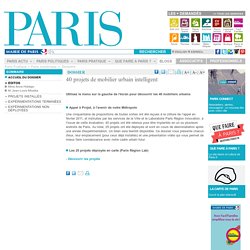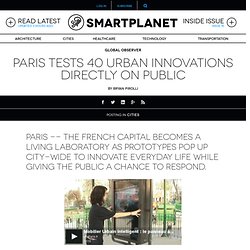

The Year of the Beacon and a staged strategy. Blog home By: Ms Jen Cork, Category: At The Museum, Date: 12 Nov 2014 2014 has been all about beacons... © Australian Museum At the Australian Museum we've been using a staged strategy to implement this new technology, aiming to create the most engaging experience for our visitors.
Over the years the museum has produced a number of different mobile applications with varying purposes. Along with these projects there have been numerous discussions regarding producing a Museum wide app. The beacon technology presented a great opportunity for the Museum, however we wanted to engage in further review before we dived in to using the technology widely within the museum. What is a beacon? There are a few definitions currently used but for our purposes we are defining a beacon as a low energy blue tooth device that transmits a signal, that signal can then be interacted with by other devices. 37 - Escale Numérique (8e) 40 projets de mobilier urbain intelligent Utilisez le menu sur la gauche de l'écran pour découvrir les 40 mobiliers urbains Appel à Projet, à l'avenir de notre Métropole Une cinquantaine de propositions de toutes sortes ont été reçues à la clôture de l’appel en février 2011, et instruites par les services de la Ville et le Laboratoire Paris Région Innovation. à l’issue de cette évaluation, 40 projets ont été retenus pour être implantés en un ou plusieurs endroits de Paris.

Au total, 25 projets ont été déployés et sont en cours de désinstallation après une année d'expérimentation. Un bilan sera bientôt disponible. Les 25 projets déployés en carte (Paris Région Lab)- Découvrir les projets. Paris tests 40 urban innovations directly on public. Mobilier Urbain Intelligent : le panneau à... par mairiedeparis PARIS – The French capital has become a living laboratory with 40 new inventive projects being implemented to improve daily life.

The goal is to envision a smarter city by outfitting public spaces with innovations to improve transportation, tourism, and communications, among other fields. So far, about half of the forty prototypes are up and running, remaining in place for up to a year. The project, entitled “Mobilier Urbain Intelligent,” or "Intelligent Urban Installations," coordinated between the Mayor’s Office and the Paris Region Lab, began in late 2010 by calling upon inventors and design agencies to submit proposals. After extensive review of 48 projects, the city chose 40 ideas to implement, putting the prototypes in place during 2012. The projects, designed by independent agencies and larger companies like JC Decaux (responsible for the Vélib bike-sharing system), can be found in neighborhoods across Paris.
Nintendo 3DS at the Louvre museum? It's not a game, it's a navigation tool. Thanks to an unlikely partnership between Japanese gaming company Nintendo and the Louvre Museum in Paris, navigating the gargantuan art museum should now be a bit easier for tourists.

On April 11, the Louvre replaced its previous audio tour system with a new batch of Nintendo 3DS devices preloaded with 700 commentaries on works of art at the museum, as well as an interactive map that helps users figure out where they are in the museum, and how to get to the next piece of art they want to check out. The new guides are designed to reach out to the Louvre's young and international customer base. Last year, the museum had 8.9 million visitors -- more than half of them under the age of 30 and two thirds of them foreign.
"Through this partnership, we wanted to bring together heritage and the innovative world of interactive entertainment through a system many people are already familiar with," Herve Barbaret, managing director of the Louvre, said in a statement. Bon voyage! Untitled.
Espace. Numériques. Art Detective Cards Evaluation. Art Detective Cards are self-directed, printed materials designed for families to explore the galleries like a "treasure hunt"—visitors search for details in works of art and then answer related questions.

In 2006, evaluators conducted a study to assess the ways that families use the cards. Participating families ("Detectives") were observed in the galleries, along with those who did not use the cards ("Explorers"). Detective families were subsequently interviewed. Evaluators assessed how the families used the cards; the effects of the cards on family learning and dynamics; and the cards' ease of use, understandability, and appeal. Download the evaluation report: Art Detective Cards Program Evaluation (70pp., 790KB) Key findings: